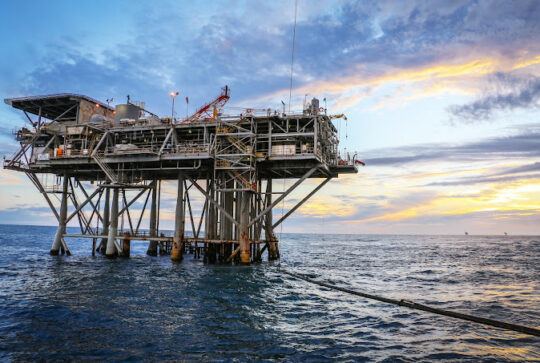December 15, 2020
Risk Management, Financial Assurance and Loss Prevention
Submitted via Federal rulemaking portal: htlp://www.regulations.gov
Department of the Interior
Bureau of Safety and Environmental Enforcement
Office of Offshore Regulatory Programs, Regulations and Standards Branch
Attention: Kelly Odom
45600 Woodland Road (Mail Code VAE-ORP) Sterling, Virginia 20166
RE: Risk Management, Financial Assurance and Loss Prevention, RIN 1082-AA02
Dear Mr. Odom,
The Gulf Energy Alliance (“GEA”) is a coalition of leading independent offshore energy producers, and we greatly appreciate the Administration’s strong leadership in promoting robust, responsible offshore energy development. We also share the Department of Interior’s commitment to ensuring ongoing investment and royalty production in the Gulf of Mexico.
Collectively, independent oil and gas companies, working in all water depths of the U.S. Outer Continental Shelf (“OCS”), contributed approximately 53 percent of the total revenues from OCS operations paid to the U.S. Treasury in 2019, and approximately 47 percent of the total 2019 OCS production.1 The single greatest regulatory challenge for independents in the Gulf of Mexico has been the cloud of uncertainty created by the absence of clear guidance on financial assurance requirements dating back to the Bureau of Ocean Energy Management’s (“BOEM”) Notice to Lessees 2016-N0l, in which BOEM overhauled the financial assurance process for oil and gas infrastructure on the OCS (the “2016 NTL”).
The GEA applauds the Department of Interior for issuing proposed regulations relating to financial assurance published in Volume 85 Federal Register 65904 et. seq. (the “Proposed Regulations”), and it is vitally important that the Proposed Regulations promptly become a final rule. The goal of the updated regulations must be to safeguard American taxpayers from ever being responsible for offshore decommissioning, while, at the same time, ensuring that the Department of Interior accomplishes its statutory obligation to make the “vital resource” of the OCS available for “expeditious and orderly development.”2 The Proposed Regulations establish the guidance and rules that the industry sorely needs and has been lacking for years. The uncertainty created by the current financial assurance regulations and guidance has hindered investment in the Gulf of Mexico. At such an uncertain time for the offshore oil and gas industry, finalizing the Proposed Regulations would give the industry the regulatory certainty it needs.
The GEA is committed to the principle that the goal for any financial assurance framework should be the “protection of American taxpayers from exposure to financial loss associated with OCS development, while ensuring that the financial assurance program does not detrimentally affect offshore investment or position American offshore exploration and production companies at a competitive disadvantage.”3 To that end, we believe the Proposed Regulations strike the critical balance between a calibrated and common sense financial assurance framework while, at the same time, creating a framework which protects the U.S. taxpayers without driving business, royalties, jobs, and new investment out of the Gulf of Mexico.
Before commenting on the Proposed Regulations, it is important to understand the history of Gulf of Mexico exploration and development. The major oil and gas companies-which comprise some of the largest corporations in the world-began developing the offshore areas of the Gulf of Mexico in the 1940s. As technology evolved, the majors began exploring in progressively deeper waters, and the independents represented by the GEA likewise participate in and focus on the development of deep water properties. Over the last 30 years, the majors sold their properties in the shallower regions of the Gulf of Mexico to focus more exclusively on deep water opportunities.4 The sales of shallow water assets were made almost exclusively to independent companies. In these transactions, the majors-recognizing their continued joint and several liability for decommissioning-faced a commercial decision: whether to maximize the cash consideration for the transaction at the time of the sale, or to accept a reduced cash consideration in addition to some form of financial assurance from the buyer upon which they could draw in order to meet decommissioning obligations which could potentially arise under the joint and several framework. In many cases, the majors made the decision to maximize the sales proceeds rather than requiring security to cover the potential decommissioning liability.
1. Independents are Addressing P&A.
Independents are meeting their plug and abandonment obligations and are methodically removing the structures that were largely installed and utilized many years ago by predecessor owners. Indeed, of the approximately 7,070 installed platforms, over 5,100-or approximately 72%-have been removed. Independents are removing approximately 100 structures every year.5 In short, the independents are addressing their obligations to remove these structures and are not leaving the American taxpayer on the hook. Imposing additional bonding requirements on the independents would only take away capital that could be deployed to continue to develop Gulf of Mexico resources and perform the decommissioning that is required under existing regulations.
2. Joint and Several Liability: a Bedrock Principle.
The Proposed Regulations recognize that joint and several liability of all current and former owners for decommissioning is a fundamental and grounding principle for the offshore oil and gas industry.6 The industry has organized itself based on this principle and billions of dollars of transactions have been consummated predicated upon this fundamental rule. Accordingly, to ensure that U.S. taxpayers never pay for decommissioning obligations, it is appropriate and expected by the regulated community that any decommissioning regulations rely on the creditworthiness of all owners and predecessors to secure the decommissioning responsibilities for offshore oil and gas properties.7
This joint and several liability is grounded in equity. The major oil and gas companies drilled wells and installed offshore infrastructure in order to enjoy the profits from producing the oil and gas fields. Indeed, the vast majority of the platforms and structures installed offshore were installed by the major oil and gas companies and other predecessors. The predecessors further profited on the sale of those properties to independent companies, and, in the context of these transactions, often received substantial security from the independents to cover potential decommissioning liability.
reserves in the U.S. GOM shelf on a stand-alone basis. With the wave of decommissioning continuing strong in the shelf- more than 100 structures being decommissioned each year- the establishment of efficient policy solutions that encourage such developments could be necessary.” (pg. 4) (Internal citations omitted). The Proposed Regulations are an important policy revision which would encourage the continued development of the shelf.
Accordingly, it is only fair to continue to hold the predecessors responsible in the event a current owner defaults on its decommissioning responsibilities. The GEA supports Interior’s reliance on this bedrock principle of liability, which has been relied upon by industry for decades.
3. Creditworthiness of Parents and Affiliates.
Language should be added to 30 CFR § 550.166 (d)(l) and (2) and 30 CFR § 556.(d)(l) and (2) to provide that additional security will not be required if the lessee, grant holder or any parent company or affiliate has the credit rating set forth in 30 CFR § 901(d)(l).8 This is consistent with the Proposed Regulations’ reliance on credit ratings, which are nearly always the credit rating of the ultimate parent company.
4. Bond Cancellation & Return of Pledged Security.
The GEA agrees with the proposal to allow for the cancellation of bonds and the return of pledged security (30 CPR§ 556.906) using the standards included in the proposed revisions to 30 CPR§§ 556.901(d), 550.166(d) or 550.101 l(d) where BOEM determines that the lessee or grant holder no longer needs to post the additional bond or security, when the operations for which the bond or security was provided ceased prior to the accrual of any decommissioning obligation, or determines that the bond or security should never have been required under the regulations.
Again, the GEA applauds the Department of Interior for tackling the important issue of financial assurance in the Gulf of Mexico. The above comments notwithstanding, the GEA agrees that Interior’s approach under the Proposed Regulations is well-founded and will lead to the dual accomplishment of ensuring that the U.S. taxpayer is never responsible for decommissioning liability while, at the same time, promoting continued investment in the Gulf of Mexico OCS. The GEA urges Interior to promptly issue the Proposed Regulations as a Final Rule.
Sincerely,
Kevin Bruce
Executive Director
Gulf Energy Alliance
2000 W. Sam Houston Parkway S, Suite 1200
Houston, Texas 77042
(713) 969-1044
1 See BSEE 2019 Production and Revenue Data, attached as Appendix l.
2 43 U.S.C. § 1332(2).
3 85 FR at 65907.
4 While the decommissioning regulations rightfully apply to the entire OCS, the GEA recognizes that the bulk of offshore infrastructure slated for decommissioning is located in the shallower waters given the history of developing progressively deeper properties.
5 Information/Briefing Report issued by BSEE and BOEM (Gulf of Mexico Data and Analysis/Leasing, Drilling and Production, Gulf of Mexico Shallow Water Potential Stranded Assets) (November 19, 2019), https://www.bsee.gov/sites/bseee.gov/files/reports//shallow-water-report-OI .pdf. In addition to documenting the consistent decommissioning activities being conducted in shallow waters by the independents, the report also highlights the marginal nature of many oil and gas fields and the important need for smart policy by Interior if the “vital resources” on the OCS are to be developed,(“… the U.S. GOM Shelf is limited in terms of resource availability. With the expected sizes matching the small reserve size under this study, the best hope for such projects on the shelf is reliance on existing facilities and infrastructure. The market conditions do not favor development of the small
6 See 30 CFR § 250.1703 Joint and several liability for all owners and predecessors). The Proposed Regulations rightly ground the regulations on joint and several liability: “Further, the proposed rule’s new approach would be rooted in the joint and several liability of all lessees, co-lessees, and predecessor lessees for all non-monetary obligations of a lease.” 85 FR at 65907.
7 Protecting the U.S. taxpayer from absorbing decommissioning liability is the government’s singular goal: “BOEM’s goal for this [financial assurance] program is to protect American taxpayers from exposure to financial or environmental risks from nonperformance of obligations associated with OCS leases and grants… ”
8 All companies included in the ultimate parent company’s consolidated financial statements should be considered for the purpose of determining the need for additional security.




